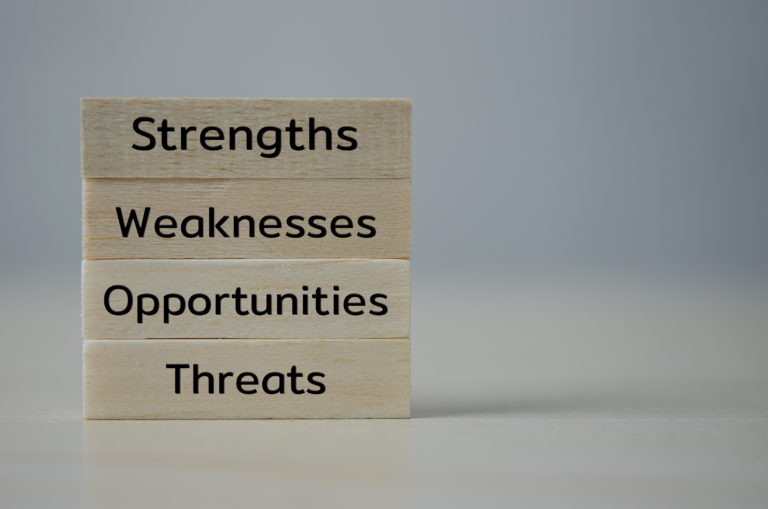Have you ever asked yourself "What makes me tick"? (If not, click HERE)
Self-awareness is a critical component of personal growth and development. It is the ability to understand yourself, including your thoughts, feelings, and behaviors. Self-awareness helps you to identify your strengths and weaknesses, which in turn enables you to make better decisions and improve your performance in different areas of your life.
In this article, we will explore the importance of understanding yourself, the benefits of identifying your strengths and weaknesses, and practical tips on how to improve your self-awareness.
Understanding yourself is vital for several reasons.
Firstly, it helps you to identify your values and beliefs. Knowing your values and beliefs enables you to make decisions that align with your principles, leading to a more fulfilling life.
Secondly, understanding yourself helps you to build better relationships with others. When you know yourself, you can communicate your needs and boundaries clearly, which leads to healthier relationships. You also become more empathetic towards others as you recognize that everyone has their unique experiences and perspectives.
Thirdly, understanding yourself helps you to make better career choices. When you know your strengths and weaknesses, you can identify which career paths are best suited for you. You can also develop skills and behaviors that are necessary for success in your chosen career.
Lastly, self-awareness is essential for personal growth and development. When you know your strengths and weaknesses, you can set realistic goals and work towards them. You can also identify areas where you need to improve, and take steps to develop yourself.

Identifying your strengths and weaknesses is a critical component of understanding yourself. Here are some of the benefits of knowing your strengths and weaknesses.
Improved Self-Esteem
Knowing your strengths helps to boost your self-esteem. When you recognize what you are good at, you feel more confident about yourself, leading to increased self-esteem.
Better Decision Making
When you know your strengths and weaknesses, you can make better decisions. You can avoid situations that play to your weaknesses and focus on activities that highlight your strengths.
Increased Productivity
When you know your strengths, you can focus on activities that you enjoy and are good at. This leads to increased productivity and efficiency in your work.
Personal Growth
Knowing your weaknesses helps you to identify areas where you need to improve. This enables you to set goals and work towards personal growth and development.
Better Relationships
When you understand your weaknesses, you can communicate your needs and boundaries better. This leads to healthier relationships with others.

Improving your self-awareness is a lifelong process. Here are some practical tips for improving your self-awareness.
Practice Mindfulness
Mindfulness is the practice of being present in the moment without judgment. When you practice mindfulness, you become more aware of your thoughts, feelings, and behaviors. This, in turn, helps you to identify your strengths and weaknesses.
Seek Feedback
Feedback is an essential tool for self-awareness. Seek feedback from trusted friends, family, and colleagues. This helps you to understand how others perceive you and identify areas where you need to improve.
Keep a Journal
Journaling is an effective tool for self-reflection. Write down your thoughts and feelings regularly. This helps you to identify patterns in your behavior and understand your motivations.
Take Personality Assessments
Personality assessments such as Myers-Briggs Type Indicator (MBTI) and the Big Five Personality Traits are useful tools for understanding yourself. These assessments help you to identify your personality traits, which in turn, enables you to understand your strengths and weaknesses.
Identify Triggers
Identify triggers that cause you to behave in a certain way. For example, if you tend to become anxious when you have a deadline approaching, recognizing this trigger can help you to manage your anxiety and improve your performance.
Embrace Failure
Failure is an inevitable part of life. Instead of being ashamed of your failures, use them as opportunities for growth and learning. Reflect on what went wrong, what you could have done differently, and what you learned from the experience.
Practice Self-Reflection
Take time to reflect on your thoughts, feelings, and behaviors. Ask yourself questions such as, "Why did I react that way?" or "What motivated me to make that decision?" This helps you to identify your strengths and weaknesses.
Surround Yourself with Supportive People
Surround yourself with people who support your personal growth and development. These people will provide constructive feedback and help you to identify areas where you need to improve.
Step Outside Your Comfort Zone
Stepping outside your comfort zone is a great way to learn more about yourself. Try new activities, take on new challenges, and push yourself to try things that scare you. This helps you to identify your strengths and weaknesses and develop new skills.
Practice Self-Care
Self-care is essential for self-awareness. Take care of your physical, emotional, and mental health. Get enough sleep, eat a balanced diet, exercise regularly, and practice relaxation techniques such as meditation or yoga.

Once you've identified your strengths, it's important to leverage them in your personal and professional life. Here are some strategies for doing so:
Set goals that align with your strengths.
When you set goals that play to your strengths, you're more likely to feel motivated and engaged in the pursuit of those goals. For example, if you're a natural leader, you may set a goal to take on a leadership role at work or in your community.
Find ways to use your strengths in new contexts.
Your strengths may be applicable in a variety of contexts beyond your current job or hobbies. Look for opportunities to use your strengths in new and different ways. For example, if you're a good communicator, you may volunteer to lead a workshop or speak at a conference.
Seek out opportunities to learn and grow.
Even if you're already skilled in a particular area, there's always room for growth and development. Seek out opportunities to learn new skills or deepen your knowledge in areas where you excel. This can help you become even more proficient in your strengths and open up new possibilities for personal and professional growth.
Surround yourself with people who appreciate your strengths.
It's important to surround yourself with people who recognize and appreciate your strengths. This can help boost your confidence and motivation, as well as provide opportunities for collaboration and learning. Seek out mentors, colleagues, and friends who share your values and interests.

Just as important as leveraging your strengths is working on your weaknesses. Here are some strategies for doing so:
Set realistic goals for improvement.
Identify one or two weaknesses that you want to work on and set realistic goals for improvement. Break down the goals into smaller, manageable steps, and track your progress along the way.
Seek out resources for learning and improvement.
There are many resources available for learning and improving in areas where you're weak. Look for online courses, books, workshops, or coaching that can help you develop new skills or overcome obstacles.
Embrace failure as an opportunity for growth.
Working on your weaknesses can be challenging and may involve some setbacks along the way. Embrace failure as an opportunity for growth, and don't let setbacks discourage you from pursuing your goals.
Ask for help when you need it.
Don't be afraid to ask for help when you need it. Reach out to colleagues, mentors, or friends who have expertise in areas where you're weak, and ask for advice or support.

Understanding yourself is essential for personal growth and development. Identifying your strengths and weaknesses enables you to make better decisions, improve your performance, and build healthier relationships with others. Improving your self-awareness is a lifelong process that requires practice, patience, and self-reflection. By following the tips outlined in this article, you can increase your self-awareness and live a more fulfilling life. Remember to embrace your strengths, work on your weaknesses, and always strive for personal growth and development.
In life, we're often faced with choices: Should we do what's right, or what's expedient? Should we stick to our values, or take the easy way out? While it can be tempting to opt for the quickest or most convenient option, taking the time to do what's truly right can make a huge difference in both our personal and professional lives. In this post, we'll explore the difference between doing what's right and what's expedient, and how understanding that difference can lead to greater success and fulfillment in all areas of life.
First, let's define our terms. What do we mean by "doing what's right"? Essentially, doing what's right means making choices that align with our values, beliefs, and priorities. It means taking the long-term view, considering the consequences of our actions, and making decisions that we can feel proud of in the long run. Doing what's right might involve making sacrifices or facing difficult challenges, but ultimately, it leads to a greater sense of purpose, integrity, and fulfillment.
On the other hand, doing what's expedient means taking the easiest or most convenient option, regardless of whether it aligns with our values or long-term goals. It means prioritizing short-term gains or immediate gratification over long-term success and well-being. While doing what's expedient can sometimes be helpful in the short-term (such as putting out a fire at work or dealing with an urgent personal issue), relying too heavily on expedient choices can lead to a lack of purpose, direction, and satisfaction.
So why does understanding the difference between these two approaches matter? In short, because the choices we make have a huge impact on our lives. When we consistently choose what's expedient over what's right, we may experience short-term gains, but we're likely to feel unfulfilled, disengaged, and directionless in the long run. When we prioritize doing what's right, on the other hand, we create a life that aligns with our values and gives us a sense of purpose and fulfillment.
Let's take a look at how this plays out in both our personal and professional lives.

In our personal lives, the choices we make can have a huge impact on our well-being, relationships, and overall happiness. Consider a few examples:
Eating junk food vs. cooking a healthy meal: When we're feeling hungry and pressed for time, it can be tempting to grab a bag of chips or order takeout. But consistently choosing these expedient options can lead to poor health, low energy, and a lack of confidence. On the other hand, taking the time to cook healthy meals that align with our values and goals can lead to better physical and mental health, more energy, and a greater sense of self-efficacy.
Binge-watching Netflix vs. spending quality time with loved ones: When we're feeling stressed or overwhelmed, it can be tempting to zone out in front of the TV for hours on end. But while this might provide some short-term relief, it can lead to a lack of connection, intimacy, and joy in our relationships. Choosing to spend quality time with loved ones - whether that means having a meaningful conversation, playing a board game, or going for a walk - can lead to greater closeness, happiness, and well-being.
Procrastinating vs. taking action: When we're faced with a difficult or unpleasant task, it can be tempting to put it off as long as possible. But this approach can lead to anxiety, stress, and a lack of progress in our personal goals and projects. Choosing to take action - even if it's just a small step - can help us feel more in control, build momentum, and make progress toward our goals.

In our professional lives, the choices we make can have a significant impact on our career trajectory, job satisfaction, and overall success. Consider a few examples:
Cutting corners vs. prioritizing quality: When we're under pressure to meet deadlines or hit targets, it can be tempting to cut corners or take shortcuts. But consistently choosing expedient options over quality can lead to a lack of trust from colleagues, clients, or customers, as well as a lack of personal pride in our work. Prioritizing quality, on the other hand, can lead to better outcomes, stronger relationships, and a greater sense of professional fulfillment.
Taking credit vs. sharing credit: When we achieve success or complete a project, it can be tempting to take all the credit for ourselves. But this approach can lead to resentment from colleagues, a lack of trust, and a reputation for being selfish or egotistical. Sharing credit with others, on the other hand, can build trust, foster collaboration, and lead to greater success in the long run.
Avoiding conflict vs. addressing issues: When we encounter conflict or difficult conversations in the workplace, it can be tempting to avoid them altogether. But failing to address issues head-on can lead to a lack of trust, resentment, and a lack of progress in our work. Choosing to address issues directly - with empathy, respect, and professionalism - can lead to better outcomes, stronger relationships, and a greater sense of personal and professional growth.
So how can we ensure that we're consistently choosing what's right, rather than what's expedient, in our personal and professional lives? Here are a few tips:
Define your values and goals: Before making any major decision, take the time to reflect on your values and goals. What matters most to you? What are your long-term aspirations? By keeping these in mind, you can make choices that align with your vision for your life.
Take the long-term view: When faced with a choice, consider the long-term consequences of each option. Will it lead to short-term gain but long-term pain? Or will it require some sacrifice or effort now, but lead to greater success and fulfillment in the long run?
Seek feedback and advice: Don't be afraid to seek feedback from trusted friends, family members, or colleagues when making a decision. They may have insights or perspectives that you haven't considered, and their feedback can help you make a more informed choice.
Practice self-awareness: Pay attention to your own thoughts, emotions, and reactions when making a decision. Are you choosing what's expedient because it's easier or more comfortable? Or are you making a deliberate choice that aligns with your values and goals?
Take responsibility for your choices: Finally, remember that every choice you make has consequences, both positive and negative. Take responsibility for your decisions, and be willing to learn from mistakes or missteps along the way.

Understanding the difference between doing what's right and what's expedient can have a profound impact on our personal and professional lives. By prioritizing our values and goals, taking the long-term view, seeking feedback and advice, practicing self-awareness, and taking responsibility for our choices, we can create a life that aligns with our deepest aspirations and leads to greater success and fulfillment in all areas. So next time you're faced with a choice, ask yourself: am I doing what's right, or what's expedient? The answer may surprise you.